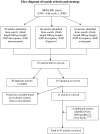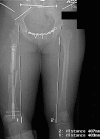Methods for assessing leg length discrepancy
- PMID: 18836788
- PMCID: PMC2628227
- DOI: 10.1007/s11999-008-0524-9
Methods for assessing leg length discrepancy
Abstract
The use of accurate and reliable clinical and imaging modalities for quantifying leg-length discrepancy (LLD) is vital for planning appropriate treatment. While there are several methods for assessing LLD, we questioned how these compared. We therefore evaluated the reliability and accuracy of the different methods and explored the advantages and limitations of each method. Based on a systematic literature search, we identified 42 articles dealing with various assessment tools for measuring LLD. Clinical methods such as use of a tape measure and standing blocks were noted as useful screening tools, but not as accurate as imaging modalities. While several studies noted that the scanogram provided reliable measurements with minimal magnification, a full-length standing AP computed radiograph (teleoroentgenogram) is a more comprehensive assessment technique, with similar costs at less radiation exposure. We recommend use of a CT scanogram, especially the lateral scout view in patients with flexion deformities at the knee. Newer modalities such as MRI are promising but need further investigation before being routinely employed for assessment of LLD.
Level of evidence: Level IV, diagnostic study. See the Guidelines for Authors for a complete description of levels of evidence.
Figures







Similar articles
-
Computed radiographic measurement of limb-length discrepancy. Full-length standing anteroposterior radiograph compared with scanogram.J Bone Joint Surg Am. 2006 Oct;88(10):2243-51. doi: 10.2106/JBJS.E.01179. J Bone Joint Surg Am. 2006. PMID: 17015603
-
Reliability analysis for radiographic measurement of limb length discrepancy: full-length standing anteroposterior radiograph versus scanogram.J Pediatr Orthop. 2007 Jan-Feb;27(1):46-50. doi: 10.1097/01.bpo.0000242444.26929.9f. J Pediatr Orthop. 2007. PMID: 17195797
-
Assessing leg length discrepancy after femoral fracture: clinical examination or computed tomography?ANZ J Surg. 2005 May;75(5):319-21. doi: 10.1111/j.1445-2197.2005.03349.x. ANZ J Surg. 2005. PMID: 15932444
-
Leg length discrepancy: A systematic review on the validity and reliability of clinical assessments and imaging diagnostics used in clinical practice.PLoS One. 2021 Dec 20;16(12):e0261457. doi: 10.1371/journal.pone.0261457. eCollection 2021. PLoS One. 2021. PMID: 34928991 Free PMC article.
-
Measurement Techniques for Leg Length Discrepancy in Total Hip Arthroplasty: A Systematic Review of Reliability and Validity.J Arthroplasty. 2022 Dec;37(12):2507-2516.e11. doi: 10.1016/j.arth.2022.05.029. Epub 2022 May 21. J Arthroplasty. 2022. PMID: 35605764
Cited by
-
Normal values for segmental bioimpedance spectroscopy in pediatric patients.PLoS One. 2015 Apr 13;10(4):e0126268. doi: 10.1371/journal.pone.0126268. eCollection 2015. PLoS One. 2015. PMID: 25875618 Free PMC article.
-
The Comparison of Lower Extremity Length and Angle between Computed Radiography-Based Teleoroentgenogram and EOS® Imaging System.Diagnostics (Basel). 2022 Apr 22;12(5):1052. doi: 10.3390/diagnostics12051052. Diagnostics (Basel). 2022. PMID: 35626207 Free PMC article.
-
Detecting the presence of leg length discrepancy based on gait deviations and functional measurement of leg length during walking.BMJ Case Rep. 2017 Aug 7;2017:bcr2017219645. doi: 10.1136/bcr-2017-219645. BMJ Case Rep. 2017. PMID: 28784874 Free PMC article.
-
Management of long bone fractures and traumatic hip dislocations in paediatric patients: study protocol for a prospective global multicentre observational cohort registry.BMJ Open. 2024 Mar 8;14(3):e079836. doi: 10.1136/bmjopen-2023-079836. BMJ Open. 2024. PMID: 38458811 Free PMC article.
-
Comparative Study of Alternative Methods for Measuring Leg Length Discrepancy after Robot-Assisted Total Hip Arthroplasty.Bioengineering (Basel). 2024 Aug 21;11(8):853. doi: 10.3390/bioengineering11080853. Bioengineering (Basel). 2024. PMID: 39199810 Free PMC article.
References
-
- {'text': '', 'ref_index': 1, 'ids': [{'type': 'PubMed', 'value': '1634580', 'is_inner': True, 'url': 'https://pubmed.ncbi.nlm.nih.gov/1634580/'}]}
- Aaron A, Weinstein D, Thickman D, Eilert R. Comparison of orthoroentgenography and computed tomography in the measurement of limb-length discrepancy. J Bone Joint Surg Am. 1992;74:897–902. - PubMed
-
- {'text': '', 'ref_index': 1, 'ids': [{'type': 'PubMed', 'value': '3871572', 'is_inner': True, 'url': 'https://pubmed.ncbi.nlm.nih.gov/3871572/'}]}
- Aitken GF, Flodmark O, Newman DE, Kilcoyne RF, Shuman WP. Mack LA. Leg length determination by CT digital radiography. AJR Am J Roentgenol. 1985;144:613–615. - PubMed
-
- {'text': '', 'ref_index': 1, 'ids': [{'type': 'PubMed', 'value': '3584448', 'is_inner': True, 'url': 'https://pubmed.ncbi.nlm.nih.gov/3584448/'}]}
- Altongy JF, Harcke HT, Bowen JR. Measurement of leg length inequalities by Micro-Dose digital radiographs. J Pediatr Orthop. 1987;7:311–316. - PubMed
-
- {'text': '', 'ref_index': 1, 'ids': [{'type': 'PubMed', 'value': '3694061', 'is_inner': True, 'url': 'https://pubmed.ncbi.nlm.nih.gov/3694061/'}]}
- Aspegren DD, Cox JM, Trier KK. Short leg correction: a clinical trial of radiographic vs. non-radiographic procedures. J Manipulative Physiol Ther. 1987;10:232–238. - PubMed
-
- {'text': '', 'ref_index': 1, 'ids': [{'type': 'DOI', 'value': '10.1097/00007632-200306150-00020', 'is_inner': False, 'url': 'https://doi.org/10.1097/00007632-200306150-00020'}, {'type': 'PubMed', 'value': '12811280', 'is_inner': True, 'url': 'https://pubmed.ncbi.nlm.nih.gov/12811280/'}]}
- Badii M, Shin S, Torreggiani WC, Jankovic B, Gustafson P, Munk PL, Esdaile JM. Pelvic bone asymmetry in 323 study participants receiving abdominal CT scans. Spine. 2003;28:1335–1339. - PubMed
MeSH terms
LinkOut - more resources
Full Text Sources
Other Literature Sources
Medical
Research Materials

